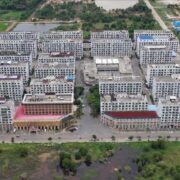Stop plundering the environment

Typhoon “Enteng” brought massive flooding, again, over a month after Supertyphoon “Carina” hit the country. If clogged drainage systems were pointed as the main culprit for the Carina floods, this time, attention was focused on rapid urbanization as the cause for the heavy flooding, particularly in elevated areas.
Enteng left 15 dead while 21 individuals remain missing, according to the Office of the Civil Defense. Most of the deaths were due to landslides and drowning with eight of them from Rizal, where many homes were covered in mud in the aftermath.
Rizal, whose capital Antipolo is about 16 kilometers east of Manila, is a mountainous province perched on the western slopes of the southern portion of the Sierra Madre mountain range. Its higher elevation has made it relatively flood-free compared to other areas including Metro Manila.
But not anymore.
President Marcos, during a situation briefing in Antipolo City on Friday, called for updated flood hazard maps to track the changes in the volume and flow of floodwater—data that should have been readily available with the more than 5,000 flood-control projects that his administration claimed to have completed. Still, the recent floods compelled the President to ask: Why is it flooding now?
Quarrying and land conversion
Ironically, local officials, who are expected to have their ears on the ground about issues concerning their localities, appear to be clueless on what has caused the floods. “[To] be honest, Mr. President, bulag po kami dito sa [local government unit],” Antipolo Mayor Casimiro Ynares III told Mr. Marcos. “The fact remains sa dami po ng rason, ’di po namin alam which contributes the most. Is it mining? Is it urbanization? Is it deforestation? Is it siltation? Is it bad land use planning or implementation?”
In July, during the onslaught of Carina, the Meta page Tara Rizal Naman posted aerial photos showing a quarry site in the province with the caption: “Sa mga nagtataka kung bakit lumalala ang baha sa Rizal.” The post went viral this week on social media triggering discussions on the floods, with the Masungi Georeserve raising the issue of quarrying and land conversion within its area and in the Upper Marikina Watershed. “[…] people are beginning to see the severe impacts of wrong land use,” it said in a post.
Rapid urbanization
However, environment undersecretary Carlos Primo David said urbanization—not quarrying operations which, he also said, only have a minimal effect—is to blame for the floods. “If we compare how much area is covered by quarries versus how much area is covered by cities and urbanized areas, [there is no] comparison at all. We’re talking about 350 hectares of quarry versus more than 20,000 hectares of urbanized area.” Nonetheless, David said, the Department of Environment and Natural Resources (DENR) would investigate quarrying operations to determine how much they have contributed to the flooding.
Ynares also said they will commission researchers to conduct a study. “But [it] would [save] us a lot of money if the national government has a study identifying which contributes the most to flooding,” he said.
Why waste taxpayer money on studies when several, in fact, already exist on the cause and effect of floods in Metro Manila especially after Tropical Storm “Ondoy” in 2009? Given the apparent cluelessness of local officials, what should be done is to update the flood data in the wake of more recent typhoons and extreme weather events. And, for once, the government both at the local and national levels should heed what experts have been campaigning for all this time to address and mitigate the effects of rapid urbanization: the enactment of a national land use plan (NaLUA) that is already almost three decades in the making.
Holistic and ethical plan
A NaLUA would institutionalize a holistic and ethical plan for using and protecting the country’s land and water resources and provide a guideline for local governments in allocating their resources and building infrastructure systems, among others. The effectiveness of a NaLUA would of course still depend on implementation, a perennial weak point for the Philippine government, but having a national blueprint could provide stakeholders with a basis to run after violators. If, as the DENR said, the “very dense” housing projects were one of the primary reasons for the Rizal floods and adjacent areas, it would be faster to pinpoint culpability.
Officials cannot continue to be reactive to the impact of extreme weather events and take action only after a disaster strikes. Beyond blaming the floods on changes in weather patterns and clogged drainage systems, they must stop the plunder of the environment and moderate activities like quarrying, mining, urban development, etc. that denude mountains and forest covers and leave irreparable damage. Next year’s mid-term elections are also a perfect opportunity for voters to boot out politicians indifferent to their plight and who are blind to the problems that affect ordinary Filipinos.





















